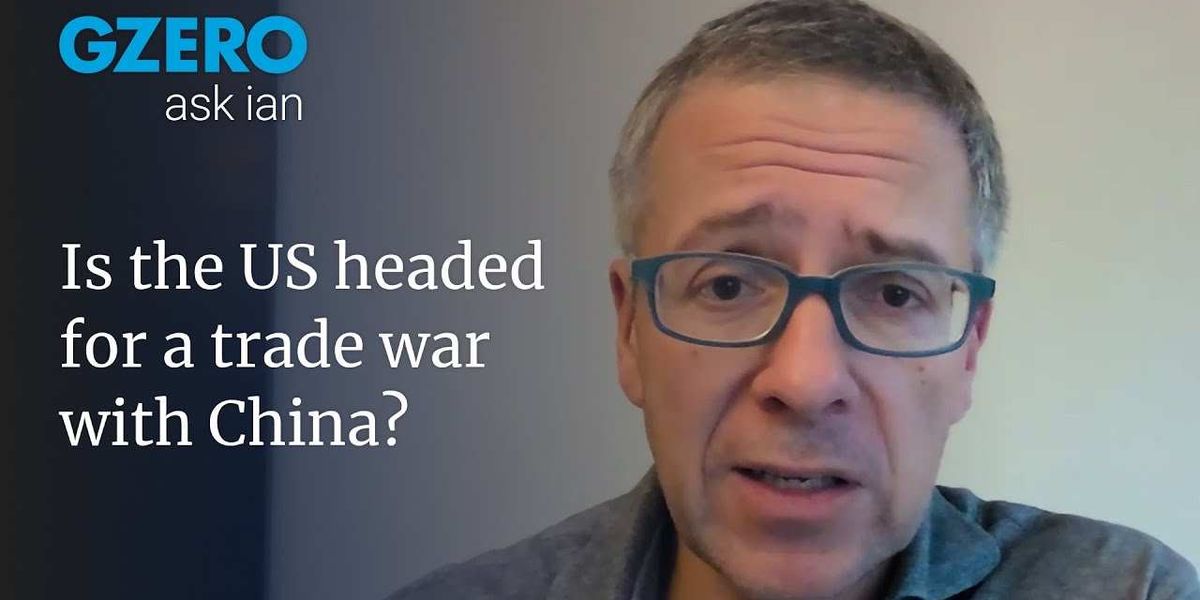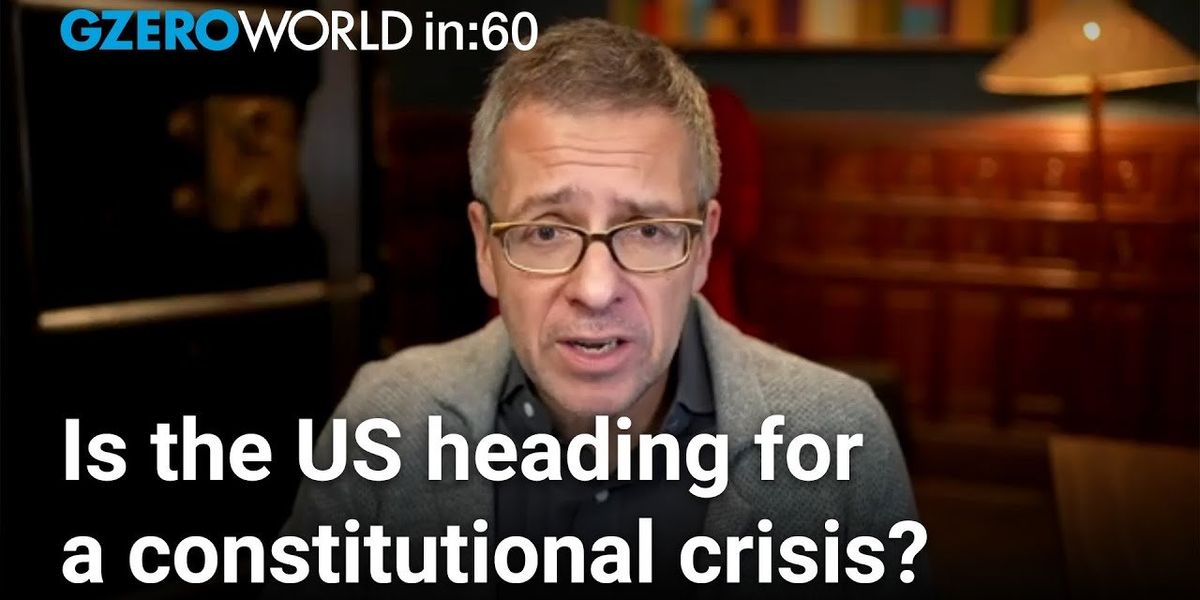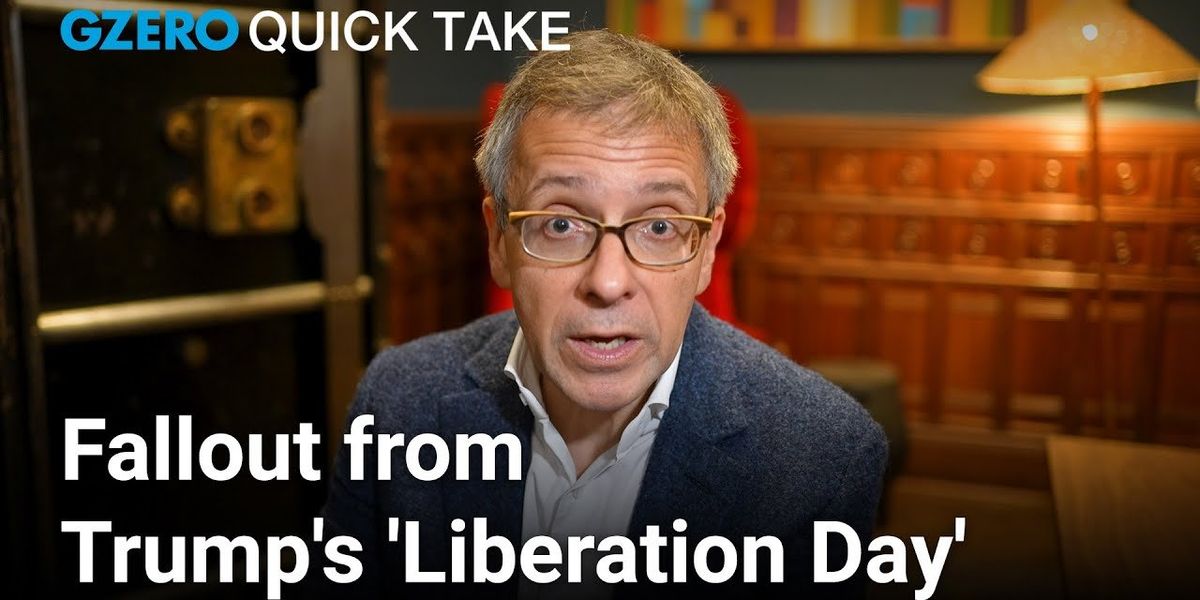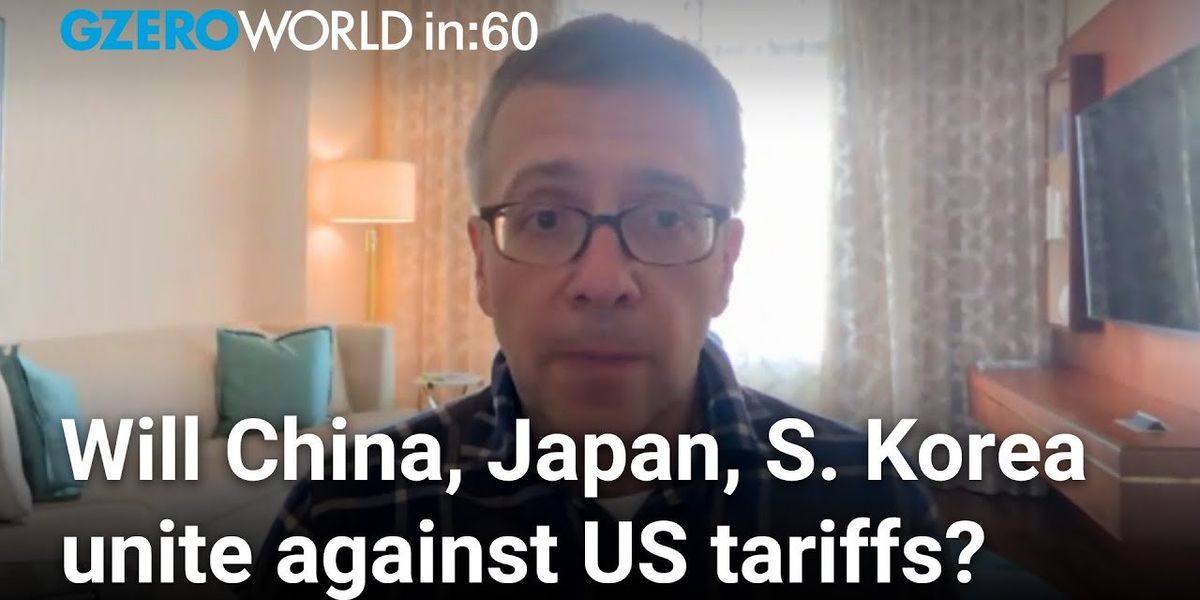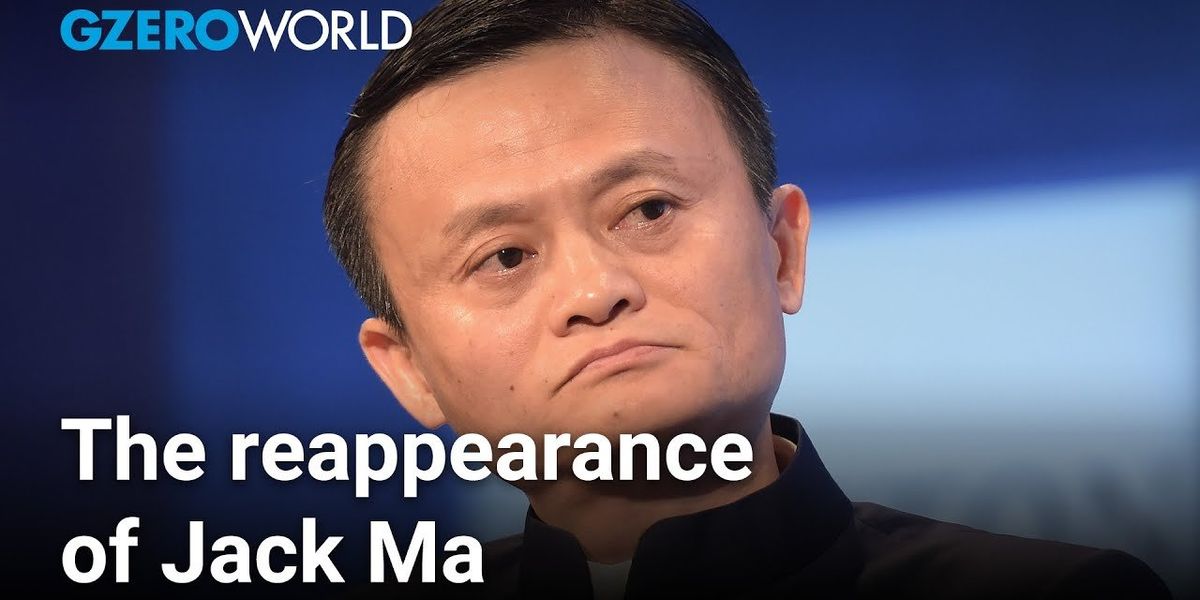Trending Now
We have updated our Privacy Policy and Terms of Use for Eurasia Group and its affiliates, including GZERO Media, to clarify the types of data we collect, how we collect it, how we use data and with whom we share data. By using our website you consent to our Terms and Conditions and Privacy Policy, including the transfer of your personal data to the United States from your country of residence, and our use of cookies described in our Cookie Policy.
{{ subpage.title }}
Trump, Xi, and the new US–China standoff
US–China relations are once again on edge. After Washington expanded export controls on Chinese tech firms, Beijing struck back with new limits on critical minerals. President Trump responded by threatening 100% tariffs, then quickly walked them back.
Ian Bremmer says neither side wants a full trade war: “Trump doesn’t want to risk inflation or crash the markets, and Xi knows both countries have real leverage over each other.”
As Trump and Xi prepare to meet, from TikTok control to Taiwan tensions, Ian explains why “this relationship is tense, but not heading for a blow-up.”
Assassination attempt shakes Colombia's political landscape
On Ian Bremmer’s World In 60 Seconds: Ian breaks down the assassination attempt on Colombia's presidential candidate, the US-China trade talks, and Canada plans to hit NATO's 2% defense target seven years early.
Ian's takeaways:
An assassination attempt on a Colombian presidential candidate highlights that “security continues to be a really serious problem,” as opposition momentum grows amid President Petro’s struggles.
On US-China trade, Ian says, “There is real progress happening,” as factory shutdown threats push both sides toward short-term stability, even if long-term trust remains elusive.
And Canada’s plan to hit NATO’s defense target early? “It’s about Trump,” Ian notes, as Ottawa moves to ease tensions with Washington ahead of 2025.
Trump’s inaction on wrongful deportation may spark constitutional crisis
Ian Bremmer shares his insights on global politics this week on World In :60.
If the US won't work to return a wrongly deported man to El Salvador despite a Supreme Court ruling, are we headed towards a constitutional crisis?
It certainly appears that way, and I think this is the constitutional crisis that the Trump administration would love to have. Because wrongfully deporting someone without evidence who is in the country illegally and therefore guilty of a misdemeanor, but sending them to a max security prison, which the Supreme Court says you shouldn't do, but now is in another country. Very few Americans are sympathetic to the case of this person. And indeed, Trump won on the basis in part of being sick and tired of allowing illegal immigrants to spend enormous amounts of time in the United States without recourse.
So he's breaking the law here. He's flouting independent judiciary and their decision-making, but he's doing it on an issue that most Americans have no sympathy on the other side. So the Democrats would have to be very wary of making this a hill they want to die on, and Trump knows exactly what he's doing. It is pretty impressive playbook for undermining rule of law and checks and balances on an increasingly authoritarian leaning executive. That's where we are.
Trump claims China-Vietnam talks are intended to "screw" the US. Does this run the risk of pushing Vietnam to China?
Certainly, most Vietnamese now are more well-disposed towards China than the US. First time we've seen that since the war. It's not true across Southeast Asia. Philippines, about 80% still pro-US, not pro-China. But it is a problem, and Xi Jinping understands that. And that's why he went in and was received directly by the president as opposed to the prime minister last time who met him at the airport. 45 big deals that they're signing on trying to improve economic coordination. Clearly a bit of a surprise to Trump, just as the direct retaliation from the Chinese, even though the Americans warned them, "Negotiate, don't retaliate." But that's exactly what China did, and Trump frankly should have expected that was coming. Now he looks a little bit weaker in the way he's backing down and creating exemptions for a lot of people in this space.
Saudi Arabia plans to pay off Syria's World Bank debt. Could this be a major turning point for Syria's future and its ties with regional allies?
It certainly helps. We've also seen the Qataris already say they're going to offer gas through Jordan into Syria. I think that this is all promising. The Saudis were never going to do that, provide any support as long as Assad was in place. Now they are. The Americans are pulling troops out, and Turkey is going to be the most important country on the ground. But economically, it's going to be the Gulf States, and that gives this new Syrian regime a better chance to succeed. Something we all clearly are rooting for in terms of one of the places that we'd like to see a little more stability from. Anyway, that's it for me, and I'll talk to you all real soon.
- Zelensky snubs China’s peace push, Trump vows to end war “very quickly” ›
- China’s vows to pump up its economy — with one eye on Trump’s tariffs ›
- El Salvador's president wins big. What does this mean for the country and its neighbors? ›
- El Salvador's Bukele refuses to return wrongly-deported Maryland man, and offers to jail US citizens too ›
Larry Summers has a few thoughts about Trump's trade war
Listen: For a special edition of the GZERO World Podcast, Ian Bremmer sits down with former Treasury Secretary Larry Summers to get his economic assessment of President Trump's unprecedented imposition of tariffs, which has sparked an escalating trade war.
"I don't see this as a rational way of either pursuing the objective of strengthening US manufacturing or the objective of reducing other countries' trade barriers," Summers tells Bremmer. "This is probably the worst, most consequential, self-inflicted wound in US economic policy since the Second World War."
Summers, who was also at one point the President of Harvard University, is especially astonished by the lack of backbone that certain institutions, from universities to law firms, have shown when it comes to standing up against the Trump administration. "History will record of the United States establishment at this moment, that it allowed itself to be especially cowed...If Harvard is not prepared to speak up... it's hard to imagine who will."
Subscribe to the GZERO World Podcast on Apple Podcasts, Spotify, Stitcher, or your preferred podcast platform, to receive new episodes as soon as they're published.
- Viewpoint: What to expect from Trump’s tariff “Liberation Day” ›
- Trump 2.0 is set to upend US-Canada relations ›
- The economic fallout of Trump’s tariff threats ›
- Trump’s tariff shadow looms over APEC summit ›
- Can Trump's tariff plan boost the US economy? ›
- Inside the Harvard-Trump showdown - GZERO Media ›
Trump tariff is starting a US-China trade war
Ian Bremmer shares his insights on global politics this week on World In :60.
Are the US and China rushing into a trade war?
Absolutely. I mean, if the Americans are actually going to impose tariffs of over 100% on Chinese exports of goods, it's essentially a trade embargo. That is a decoupling, and it's an unmanaged decoupling of US-China direct trade. Still an awful lot of goods from China to get to the United States through third countries. It's not clear all those will be cut off as the US negotiates with a lot of those countries. So people in America will still be buying Chinese goods, but inflation's going to go up. There's no question. And this is going to end up hurting the Chinese even more than it hurts the United States.
With an in-person nuclear talk set for Saturday, how confident is Trump that he can rein in Iran's nuclear program?
Well, it's interesting. What Trump is saying is that Iran will not be allowed to have nuclear weapons. That's different from what Israeli Prime Minister Benjamin Netanyahu has been saying, which is that they cannot have a nuclear program of any sort. Trump wants to rein the program in. He did announce that there are going to be direct talks between the US and Iran. Iran didn't quite say that. They said they're having indirect talks, but if they go well, they'll lead to direct, which is certainly a concession to the Americans. And it's interesting that Trump did that while the Israeli prime minister was in the Oval Office visiting him. Bibi thought he was coming over for tariff relief, and what he got was Trump saying that Erdogan's his bestie, that the Israelis should be really thankful they get billions from the US, the tariffs aren't going anywhere, and that there's going to be negotiations with Iran. Really interesting. I think Bibi's got to be unhappy on his flight back to Israel.
Zelensky claims Ukrainian troops have captured two Chinese nationals fighting for Russia. How does it change the dynamics of the war?
Not at all. It does reflect the fact that Ukraine is under an awful lot of pressure and is trying to do anything they can to stay in the headlines, stay relevant, keep the Americans engaged and focused. I'm not surprised that there are two Chinese nationals fighting in Ukraine. Doesn't mean they were sent by the Chinese PLA. I mean, there are American nationals that have been fighting for the Ukrainians and it's not because they're sort of involved with NATO or sent by the US government. So I really don't think there's any there, but important enough for you to ask question. That's it for me. I'll talk to you all real soon.
Trump's tariffs & the end of globalization
Ian Bremmer's Quick Take: It is the day after 'Liberation Day,' April 2nd. I'm not sure that day is going to stick. It was good not to do on April 1st. Not only because it's April Fools, but also because you had a couple of key elections in the US, in Florida and in Wisconsin. And Trump clearly wanted to go after that because he knew that these weren't going to be super popular. And yet, this is exactly what he was promising.
He has been promising tariffs. He's been promising securing American borders, securing borders from people coming into the US illegally, also securing US borders from unfair trade practices. And that is precisely what we're seeing right now. Overnight, the United States is moving to having the highest tariffs against countries of any major economy in the world by a very long margin, and also the largest average trade tariff in over a hundred years.
This is a new era. It's a post globalization era. It's a post post-war era. It's kind of the equivalent of what the Brits did with Brexit just on a global scale. Now, why these tariffs and what's behind the percentages? Because Trump's been talking about reciprocal tariffs for a very long time, and yet these aren't reciprocal. There are no countries that have the percentage tariffs on the US that the US is now putting on them in terms of goods. So how did they do that? That's the extraordinary thing, is the calculation wasn't based on the tariffs that are imposed on US goods. Rather, it was a look at the trade deficit that the US runs against those countries and taking the percentage of what the trade deficit is and applying a tariff that would get you to parity. In other words, what reciprocal from Trump's perspective is whatever would actually bring that trade deficit into trade neutrality and then just impose half of that, which makes no sense economically whatsoever.
Why not? Well, first of all, because there are a lot of poor countries around the world that have trade deficits with the US because they can't afford American goods, and the US wants to buy commodities, for example, from those countries or low tech manufacturer like from Bangladesh. And are you angry because the Bengalis aren't capable of buying Teslas from the US or buying smartphones? And the answer is, of course not. And all that's going to be is a tax. The US government will pick up revenue and the Americans will have to pay more for inexpensive goods that the US isn't going to produce. Some cases, these are goods that the Americans not only wouldn't want to produce because the labor quality and cost is really, really low and no one's going to do that work, especially when you're closing borders and taking illegals out of the population. But also, because the US economy couldn't produce them.
I mean, your tropical fruits, I mean some of them can be in the United States, but most of them need to come from other places. Coffee beans, I mean all sorts of things that the Americans are just not going to be substitution effect producing that now are just going to be higher costs for the United States, for average Americans. And then in places where the US was not in deficit, then you're just throwing a 10% tariff against. Why? Is that about fair trade? No, that's just about the Americans wanting to ensure that there are tariffs on absolutely everyone. It reminds me of the January 6th conversation where originally Trump was talking about, "Well, maybe we've got to look more carefully at all the really violent types and we're not going to want to give them amnesty. But there are a lot of people that were treated very badly, very unfairly, and so they should have amnesty and they should be pardoned."
And as the details and the debates on who should and shouldn't get a pardon came out, Trump got sick of the debate, got sick of the nuance, and said, "I'm just giving it to everybody." And I think that's what happened with tariffs. There were debates going on with large numbers of advisors around Trump, right until the last minute and he just said, "Ah, I'm just putting tariffs on everybody." And that's what's happened. And now there will be individual deals that will be cut with a bunch of countries to try to get out of that. But the reality is that the biggest trade partners of the United States, there's no quick fix. Not with Europe, not with Mexico, not with Canada, not with China. And given that, we are clearly not only out of a US-driven globalization era... That's been gone for some time now. Globalization has been moving apace, but the US has not been driving it.
The US had been kind of standing on the sidelines and pushing their own industrial policy. But now you have the United States actively unwinding globalization. And the question will be how effective will other countries be in playing defense, in hedging, and in bringing some production, more production to the United States? Because in the near-term, you expect to see a lot of countries will try to limit the damage that's being done. And the US economy is, of course, stronger and more powerful. So that will mean that a lot of countries won't immediately do reciprocal tariffs, but will try to cut deals with the Americans. A lot of companies will try to find ways to manufacture more in the US. That's near-term.
In the medium and long-term, there will be hedging. There will be efforts to find ways to de-risk their economies from the United States, from the uncertainty, the volatility, the high costs. And sure, you'll want to produce things in the US for US consumers, but most things are not being consumed by Americans. And that is increasingly true around the world. And therefore you wouldn't want to produce most things in the US in that environment. So you'll see more hedging of the Europeans towards other countries, including in some non-AI fields towards China. And I think you'll see that in bigger ways in the Global South who already have their principal trade partners as China anyway.
And then final point is keep in mind that the Americans are not really good at being patient. And Trump has been talking the entire way, not one of the most patient people in the world that, "Look, I mean, yeah, they're going to be costing in the near-term, and I don't care if the cost of cars go up. But long-term, this is good for Americans." And certainly near-term there's going to be a significant economic hit, not just in the stock market, but also in US GDP and also in inflation. And Americans, I suspect are going to be pretty angry about that because Americans are very short-term in orientation. It's a nature of free market capitalism, kleptocratic or not in the US and it's also the nature of the political system.
So that's where we are. A lot to think about on the back of these unprecedented policy moves. And remember, it is a marathon, not a sprint. We are only a couple months in. Trump has four full years, and a lot is going to happen over the course of that administration. And I'll be here to talk to you about it. Thanks a lot, and I'll talk to you all real soon.
What if Japan & South Korea sided with China on US tariffs?
Ian Bremmer shares his insights on global politics this week on World In :60.
If China, Japan, and South Korea formed a united front, what kind of leverage would they have in negotiating against US tariffs?
Oh, if that were to happen, they'd have incredible leverage because China's the second-largest economy in the world, Japan's the third. This would be a really, really big deal. Except for the fact that it's not going to happen. Their trade ministers did just meet, and they've had some interesting coordinated statements. They do a lot of trade together, and they want to continue that. But the fact that the security of South Korea and Japan is overwhelmingly oriented towards the US, and they would not want to undermine that, means that they will certainly not see China as a confederate to coordinate with against the United States, not least on trade. The American response would be belligerent. So no, that's not going to happen.
Will Syria's newly formed transitional government be enough for Arab and Western leaders to lift sanctions and restore diplomatic ties?
I think they are heading in that trajectory. The question is, will it be enough to keep Syria stable and away from descending into civil war? And there, there's a huge question because this is a completely untested government, completely inexperienced, no governance background, very little background in terms of military stability, especially with all of the new members, militias that have been integrated from across a very diverse country. And a lot of internal opponents that are sitting back and waiting to fight. So I'm more worried about that than I am about international support. I think largely the international support they need is going to be there.
Why does Trump want to take Greenland?
I have no idea. Maybe somebody showed him a globe from the top and he saw how big it was, and he's like, "Oh, that'd be kind of cool to have." It's not like there's anything he needs that he can't get directly from negotiating with Denmark. Plenty of willingness to allow the US to have expanded bases, troops on the ground. Plenty of willingness from other countries in the region to do more in terms of patrolling, build more icebreakers to deal with. The Finnish President, Alex Stubb, who just went to see him golfing with him, spent seven hours over the weekend moving in that direction. But you saw from Vice President Vance, he's like, "Well, the President wants it. So of course I got to respond to that." Yeah, but they don't have any reason. And I do think that it is sufficiently blowing up in their faces on the ground in Denmark and in Greenland, that the Danes understand not to make a big deal out of this and it will eventually blow over. It is annoying to them symbolically, but it doesn't matter all that much. In that regard, we can spend a little bit less time on it. Okay, that's it for me. I'll talk to you all real soon.
Why China's Xi Jinping needs Jack Ma
Jack Ma, the billionaire founder of tech giant Alibaba, was once synonymous with entrepreneurship in China. But in 2020, he disappeared from public view after criticizing the country’s financial system amid President Xi Jinping’s crackdown on the tech sector. Recently, however, it seems Jack Ma may be back in the Communist party’s good graces. On GZERO World, Ian Bremmer spoke with China analyst and Sinocism author Bill Bishop about the meaning behind Ma’s apparent reemergence and rehabilitation. He appeared alongside Xi at a symposium for business leaders in February, an indication that the Chinese president is trying to engage with the private sector as he works to revive China’s sluggish economy. But is this a fundamental realignment of Xi’s priorities or a temporary reprieve?
“I don't think there's a lot of people who believe that the Communist Party changed its view of private business, which is they're there to be harnessed and managed and controlled,” Bishop explains “But they understand that they need people like Jack Ma, they're not just the best entrepreneurs in China, they're some of the best entrepreneurs in the world.”
Watch full episode: China’s next move
GZERO World with Ian Bremmer, the award-winning weekly global affairs series, airs nationwide on US public television stations (check local listings).
New digital episodes of GZERO World are released every Monday on YouTube. Don't miss an episode: subscribe to GZERO's YouTube channel and turn on notifications (🔔).GZERO World with Ian Bremmer airs on US public television weekly - check local listings.
